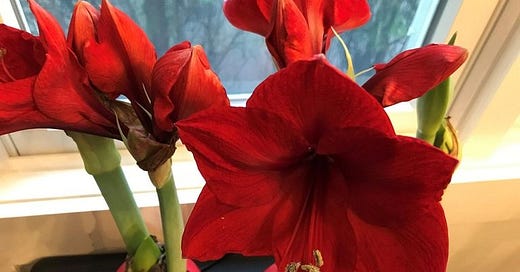Can your holiday Amaryllis have another life? You have options!
Plus: Wisdom from fellow Weekly Dirt-ers and rejuvenating a Japanese holly
Hi, guys!
I hope you enjoyed the New Year’s festivities or lack thereof (I tend to like these things on the quieter side)! And now that 2024 is in the rearview mirror, it’s time to start strategizing our 2025 gardens.
I’ve already noted the plants I’d like to move (three roses) and the ones I’d like to add in spring (several greenish-white hydrangeas — still deciding on which).
But right now, I’m saying goodbye to my wax-dipped Amaryllis. Such bulbs have been pre-soaked and treated to bloom just once, so they should be ditched when their foliage fades. RIP.
But if you potted up a bulb in October or were gifted a blooming specimen, you have options.
The common species of holiday Amaryllis is a tropical plant that’s reliably hardy only in Zone 10 and up (or, rarely, Zone 8 with protection). But even in their home climate, holiday Amaryllis have been forced to bloom out of season, so they won’t likely have any energy left to flower again over summer, their natural bloom time.
Nevertheless, plants don’t read books or catalog descriptions — and they sometimes surprise us. Climate change means zones are warming, and even a slight change, like the recent gradual shift to Zone 7b from 7a in my own garden, means we might be able to get away with some risky behavior.
So, if you’re not in a tropical region and would like to experiment, remove the foliage when it dies, and store the bulbs in a cool, dry, dark spot (closet, cellar, etc.) until the danger of frost has passed, then plant them outdoors in a protected spot (against a wall or fence is ideal) in full sun, 5 to 6 inches deep. Blanket the soil with 4 or 5 inches of mulch. (In zones 10 and up, the bulbs are best planted just under the soil line or with their tops exposed.)
Keep the soil moist and apply fertilizer. Remember, you won’t get blooms this summer because the plants are tired; but if they survive, they might put on a show next year.
Apply another 4 to 5 inches of mulch in autumn, and accept that your bulbs might not survive winter. But, hey, at least you tried.
Another approach for the risk-averse: Dig up bulbs in fall as soon as their foliage dies down and store them indoors in a cool, dark place over winter, then replant after the danger of frost has passed. You have nothing to lose except a few minutes and a bulb you likely would have discarded.
To enjoy your holiday plant outdoors and still have indoor blooms next December, set the pot outside in spring (gradually acclimating it to its new environment over several days). Leave it out until September, watering regularly and fertilizing monthly. Again, it won’t bloom, but the sun it soaks up will replenish its energy for superior blooming around the winter holidays.
Another option — and the most common practice — is to keep the potted bulb indoors until next year: After the flowers fade, remove the stalks, treat it as a houseplant in the sunniest part of your home, and water it regularly. When the foliage turns yellow and withers, remove it and stop watering. The official recommendation dictates you then store the pot in a dark, cool place until late November or early December to allow it to rest; then bring it back into the main area of the house and resume watering.
To be honest, I’ve never bothered moving mine, yet I have had excellent results in the past. I simply continued watering until the leaves faded, removed them and left the pots in a corner of the living room, ignoring them for the rest of the year. As if on cue, they sent up stalks in December when I resumed watering. They bloomed just fine around the holidays.
If you’re not interested in doing any of this and just want to grow Amaryllis in your garden, look for a hardy variety bred to withstand colder temperatures, such as Hippeastrum x johnsonii, Hippeastrum sonatini or Amaryllis bella.
Keep reading with a 7-day free trial
Subscribe to The Weekly Dirt with Jessica Damiano to keep reading this post and get 7 days of free access to the full post archives.





